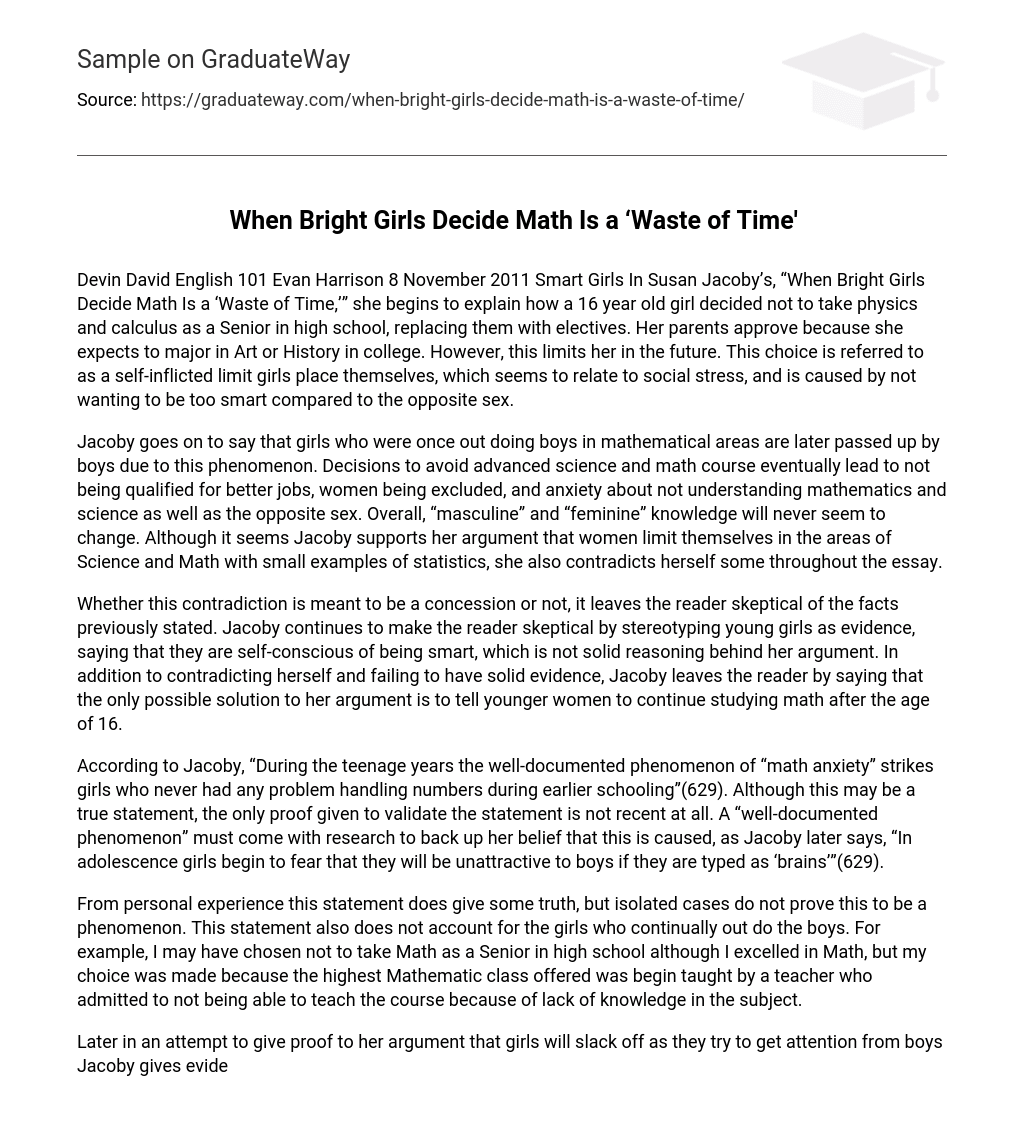In Susan Jacoby’s, “When Bright Girls Decide Math Is a ‘Waste of Time,’” she begins to explain how a 16 year old girl decided not to take physics and calculus as a Senior in high school, replacing them with electives. Her parents approve because she expects to major in Art or History in college. However, this limits her in the future. This choice is referred to as a self-inflicted limit girls place themselves, which seems to relate to social stress, and is caused by not wanting to be too smart compared to the opposite sex.
Jacoby goes on to say that girls who were once out doing boys in mathematical areas are later passed up by boys due to this phenomenon. Decisions to avoid advanced science and math course eventually lead to not being qualified for better jobs, women being excluded, and anxiety about not understanding mathematics and science as well as the opposite sex. Overall, “masculine” and “feminine” knowledge will never seem to change. Although it seems Jacoby supports her argument that women limit themselves in the areas of Science and Math with small examples of statistics, she also contradicts herself some throughout the essay.
Whether this contradiction is meant to be a concession or not, it leaves the reader skeptical of the facts previously stated. Jacoby continues to make the reader skeptical by stereotyping young girls as evidence, saying that they are self-conscious of being smart, which is not solid reasoning behind her argument. In addition to contradicting herself and failing to have solid evidence, Jacoby leaves the reader by saying that the only possible solution to her argument is to tell younger women to continue studying math after the age of 16.
According to Jacoby, “During the teenage years the well-documented phenomenon of “math anxiety” strikes girls who never had any problem handling numbers during earlier schooling”(629). Although this may be a true statement, the only proof given to validate the statement is not recent at all. A “well-documented phenomenon” must come with research to back up her belief that this is caused, as Jacoby later says, “In adolescence girls begin to fear that they will be unattractive to boys if they are typed as ‘brains’”(629).
From personal experience this statement does give some truth, but isolated cases do not prove this to be a phenomenon. This statement also does not account for the girls who continually out do the boys. For example, I may have chosen not to take Math as a Senior in high school although I excelled in Math, but my choice was made because the highest Mathematic class offered was begin taught by a teacher who admitted to not being able to teach the course because of lack of knowledge in the subject.
Later in an attempt to give proof to her argument that girls will slack off as they try to get attention from boys Jacoby gives evidence from a 1981 assessment of female achievement in mathematics, “based on research conducted under a National Institute for Education grant, found significant differences in the mathematical achievements of 9th- and 12th-graders. At age 13 girls were equal to or slightly better than boys in tests involving algebra, problem solving and spatial ability; four years later the boys had outstripped the girls” (629). This documentation has numerous flaws; first, “significant differences” are not specified creating an illusion that this must be a large number but never supporting this claim. The next flaw that Jacoby makes is she does not state what level of math was being tested and what it was compared to four years later.
Jacoby also does not give the evidence of change between the four years. This lack of evidence leaves the reader questioning if the girls dropped math as Jacoby claims that girls tend to do in order to take up more liberal, “feminine” subjects. Also, the test does not clarify whether both sexes tested in the same classes and how much of a difference was made, or if the same group of students were tested again. the proof does not validate her claim because of these conflicting elements.
Another argument Jacoby tries to present but fails to gives adequate proof for is that Mathematics and Science are masculine subjects, therefore women tend to avoid them choosing more liberal subjects such as English and History which she claims are more feminine subjects. Jacoby states, “At coeducational universities women are overwhelmingly concentrated in the fine arts, social sciences, and traditionally female departments like education.
Courses leading to degrees in science and technology-related fields are filled mainly be men” (629). In order to make this statement valid evidence, some type of statistics are needed with documentation. In attempt to give more proof she contradicts herself greatly by giving examples of men and women going against the typical stereotypical gender subjects stating, “while some well known men of letters proudly announce that they understand absolutely nothing about computers or, for that matter, about electricity. This lack of understanding is nothing in which women or men ought to take pride ” (Jacoby, 630). This entire paragraph counters her whole argument about masculine and feminine subjects and that girls in early adolescent leave the harder subject to boys. In Jacoby’s conclusion her only suggestion to solving this problem is for young women to continuing educating themselves in the harder science subjects in order to remove “intellectual handicaps” in the opposite stereotypical gender fields.
Although this solution may help solve the problem for some girls, the solution is not adequate to the problems Jacoby presents and even furthers the fact her arguments did not have enough sufficient evidence. Whether or not a girl choosing to not take mathematics at an early age for social reasons is not presented well enough to be the cause of anxiety later in life.





